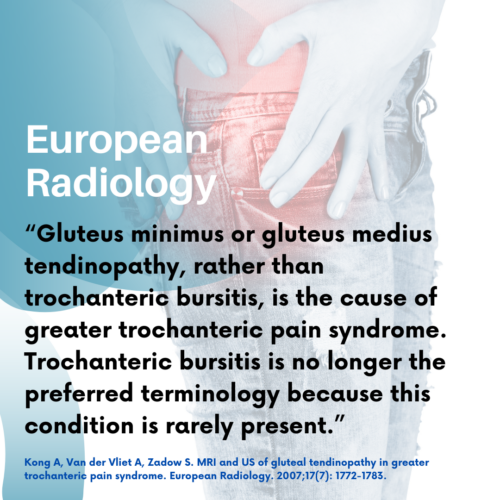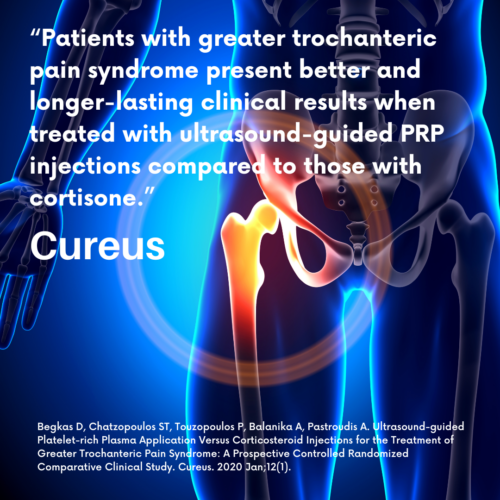We see quite a few patients who come to our office for treatment of bursitis who do not actually have bursitis. Bursitis is so painful that even touching the skin over the painful area is difficult to tolerate.
The term greater trochanteric pain syndrome is used to encompass hip pain that is related to the gluteal tendons or the trochanteric bursa. These conditions may involve tears, gluteal tendon degeneration, or bursa inflammation (bursitis).
SAGE Open Medicine researchers note, “Greater trochanteric pain syndrome encompasses a spectrum of pathologies (diagnoses), including trochanteric bursitis, external coxa saltans (snapping hip syndrome), and abductor tendinopathy and tears. Given this heterogeneity (diversity and controversy in diagnosis) and the high rate of comorbid conditions, diagnosis can be challenging.”(1)

Hip Bursitis, or trochanteric bursitis, is actually rare! Multiple studies have shown that patients presenting with bursitis-type symptoms actually have tendinopathy (tendon degeneration) of their gluteal tendons. These tendons attach near the bursa and often fool providers into thinking the patients have bursitis. Badly degenerated tendons are what they really have. And they need regeneration!
On top of that, steroid injections are often used as the treatment for true bursitis. So when steroids are injected into the degenerated tendons, they actually can cause them to degenerate faster! Sure, these treatments may give some relief, but many people continue to experience a substantial amount of discomfort even after trying them. Plus, continued use of steroids injected into a degenerated joint can, unfortunately, increase the rate of degeneration.
A study in the Journal of Orthopaedic & Sports Physical Therapy says, “The medical community once thought that a swollen hip bursa was the source of such pain, which led to the use of corticosteroid injections to the bursa to help decrease swelling and pain. However, researchers now believe that injuries to the muscles and tendons around the hip are the actual cause of this pain and that inflammation is often not involved.” (2)
As noted earlier, bursa, inflammation, or bursitis may not cause the hip problem, but tendinopathy, which results from hip instability.
Tendinopathy of the gluteus minimus or gluteus medius is often the root of greater trochanteric pain syndrome rather than bursitis. It makes sense then to treat the pain with regenerative treatments to get to the source of the problem.
Regenerative Orthopedics, including Stem Cell Therapy, PRP, and Prolotherapy, is a safe and effective treatment option for bursitis, tendinopathy, and other underlying soft tissue injuries of the hip.
True bursitis is an inflammation of the bursae, tiny, fluid-filled sacs that lubricate and cushion pressure points between the bones, tendons, and joint muscles. The bursae help the joints move easily, so movement or pressure can be painful when they become inflamed. Bursitis often affects areas around the joints in the elbows or hips.
Hip bursitis involves an inflamed bursal sac between the hip bone and glutei muscle attachments. The bursal sac inflames because of injury to the soft tissue structures. The bursal sacs decrease the friction between the soft tissue structure and the underlying bone, allowing the tendon or muscle to glide across the bone more easily. Bursitis pain usually disappears within a week with proper treatment, but recurrent flare-ups are common and frustrating.
“Isolated trochanteric bursitis as the cause of refractory lateral hip pain appears to be rare. We believe that the presence of hip abductor tendon pathology in lateral hip pain has been severely underestimated and a shift in focus towards treatment of these structures is necessary.”(3)
Chronic hip pain that is thought to be bursitis may very well be due to hip joint instability. Greater trochanteric pain syndrome begins with damage to the hip joint soft tissue. Loose, weakened, and damaged hip ligaments create hypermobility and abnormal joint motion, leading to inflammation and eventual problems of degenerative hip disease. When the hip is wobbly, the bursa becomes inflamed to help stabilize the hip. Instability is the underlying issue that leads to many hip pain conditions, including trochanteric tendonitis or bursitis.
Symptoms of hip bursitis include a dull ache or stiffness in the affected hip. Bursitis pain often worsens with movement or pressure. And the area may be swollen and feel warm to the touch. Intermittent redness of the skin in the area of the inflamed bursae may be another symptom.
Visible swelling or skin redness is usually absent from bursitis of the hip because the bursae are located beneath some of the body’s bulkiest muscles. Pain is primarily centered over the greater trochanter, a portion of the femur that juts out just below where the bone joins the hip.
“Greater trochanteric pain syndrome (GTPS) is a common clinical condition that can affect a wide range of patients. Historically, the condition has been associated with trochanteric bursitis. More recently, however, a growing body of literature has demonstrated gluteus medius tendinopathy and tearing is present in many cases of Greater trochanteric pain syndrome. Pathology of the gluteus medius can result in significant hip pain, loss of motion, and decreased function. Affected patients characteristically have symptoms including lateral hip pain and a Trendelenburg gait, which may be refractory to conservative management such as non-steroidal anti-inflammatory drugs (NSAIDs), physical therapy, and injections. In these cases, both open and arthroscopic repair techniques have been described.” (4)
“Gluteus minimus or gluteus medius tendinopathy, rather than trochanteric bursitis, is the cause of greater trochanteric pain syndrome. Trochanteric bursitis is no longer the preferred terminology because this condition is rarely present.” (5)
Bursitis is an inflammation of the fluid-filled sac, or bursa, between a tendon and skin or between a tendon and bone. Treatment often involves the use of non-steroidal anti-inflammatory drugs (NSAIDs) such as ibuprofen and steroids such as cortisone.
If the problem is not true bursitis, steroid injections to decrease inflammation will usually not eliminate the pain since inflammation is not the real problem. The steroid will, however, inhibit fibroblastic proliferation, the process by which soft tissue structures such as ligaments, tendons, and muscles grow and repair, resulting in a weakening of the joint.
NSAIDs are associated with a higher risk of cardiovascular- and gastrointestinal-related adverse events. The FDA issued a medication guide for NSAIDs recommending physicians prescribe the lowest dose for the shortest time possible.”(6)
As physicians become educated on the side effects of these medications, they hopefully will decrease their use of them. “As years of experience increased, practitioners were more likely to prescribe lower doses of corticosteroid in musculoskeletal injections.”(7)
Newer therapies are sought to replace NSAIDs due to their significant side-effect profile. Regenerative Orthopedics is both a safe and effective treatment option for bursitis pain from various causes.
First, consider whether the diagnosis is correct for the person diagnosed with bursitis. Studies on hip bursitis, as noted earlier, demonstrate that the issue is tendinopathy rather than bursitis.
“Some studies have questioned the real involvement of the trochanteric bursa in greater trochanteric pain syndrome, and tendinopathy of the gluteus medius and/or minimus has been proposed as an important cause of this syndrome.”[8] One study of 75 patients with pain and point tenderness over the greater trochanter revealed that only 8 had fluid pooling in the trochanteric bursae per sonography. (9)
Another study showed that only a minority of patients had bursitis because in 700 out of 877 patients, the pain was not from bursitis, but rather, it related to “some combination of pathology involving the gluteus medius and gluteus minimus tendons as well as the iliotibial band.”(10)
One more found that only 5 of 124 patients with trochanteric pain had bursitis, plus most of those with bursitis also had associated tendinopathy. (11)
Regenerative Orthopedics stimulates the body to repair painful areas, including those with true bursitis and tendinopathies. An experienced Regenerative Orthopedics doctor can ascertain what structure is causing the pain.
The soft tissue structures attached to the greater trochanter are often involved in hip bursitis. Regenerative Orthopedic treatments stimulate the repair of these structures. Once they are fully repaired, the pain resolves.
Platelet-rich plasma (PRP) is one of the Regenerative Orthopedic treatment options that may be recommended for bursitis pain.

A study presented at the 2014 meeting of the American Academy of Surgeons showed PRP to be very effective in the treatment of severe bursitis of the hip. The study compared one injection of PRP to one injection of cortisone. The cortisone demonstrated only short-term effectiveness. PRP provided both short and long-term pain relief from a condition that is difficult to treat successfully.”(11)
When comparing Cortisone injections to PRP, a study in Cureus showed that “Patients with greater trochanteric pain syndrome present better and longer-lasting clinical results when treated with ultrasound-guided PRP injections compared to those with cortisone.” (12)
Regenerative Orthopedic options like Stem Cell Therapy, Platelet Rich Plasma, and Prolotherapy all accomplish repair of the affected soft tissue. Your clinician will recommend which treatment will most effectively repair and regenerate your hip, bringing relief from bursitis pain.
(1) Pianka MA, Serino J, DeFroda SF, Bodendorfer BM. Greater trochanteric pain syndrome: Evaluation and management of a wide spectrum of pathology. SAGE Open Medicine. 2021 Jun;9:20503121211022582.
(2) Hip Pain: Dry Needling Versus Cortisone Injections. J Orthop Sports Phys Ther 2017;47(4):240.
(3) Lange J, Tvedesøe C, Lund B, Bohn MB. Low prevalence of trochanteric bursitis in patients with refractory lateral hip pain. Danish medical journal. 2022 Jun 15;69(7).
(4) Long SS, Surrey DE, Nazarian LV. Sonography of Greater Trochanteric Pain Syndrome and the rarity of primary bursitis. American Journal of Roentgenology. 2013; 201(5): 1083-1086.
(5) Kong A, Van der Vliet A, Zadow S. MRI and US of gluteal tendinopathy in greater trochanteric pain syndrome. European Radiology. 2007;17(7): 1772-1783.
(6 )Sofat N. Kuttapitiya A. Future directions for the management of pain in osteoarthritis.Int J Rheumatol. Apr 2014; 9(2): 197–276.
(7) Lazaro D, Alon L, Ramessar N, Cabas-Vargas J, Shwin K, Stefanov D. Intra-articular, bursa, and tendon sheath injections: A survey of practice patterns among members of the American College of Rheumatology. Journal of Rheumatology.2014; 20(2): 91-93. doi: 10.1097/RHU.0000000000000080
(8) Quiroz C, Ruta S, Rosa J, Navarta DA, Garcia-Monaco R, Soriano ER. Ultrasound evaluation of the Greater Trochanter Pain Syndrome: Bursitis or tendinopathy?
(9) Connell DA, Bass C, Sykes CJ, Young D, Edwards E. Sonographic evaluation of gluteus medius and minimus tendinopathy. European Radiology. 2003; 13(6): 1339-1347.6.
(10) Long SS1, Surrey DE, Nazarian LN.Sonography of greater trochanteric pain syndrome and the rarity of primary bursitis.AJR Am J Roentgenol. 2013 Nov;201(5):1083-6. doi: 10.2214/AJR.12.10038.
(11) Goel K,Riley LP. Platelet Rich Plasma (PRP)treatment more effective than cortisone for severe hip bursitis. http://www.aaosannualmeetingpresskit.org/2014/news_briefs/downloads/PRP-HipBursitis.pdf.
(12) Begkas D, Chatzopoulos ST, Touzopoulos P, Balanika A, Pastroudis A. Ultrasound-guided Platelet-rich Plasma Application Versus Corticosteroid Injections for the Treatment of Greater Trochanteric Pain Syndrome: A Prospective Controlled Randomized Comparative Clinical Study. Cureus. 2020 Jan;12(1).